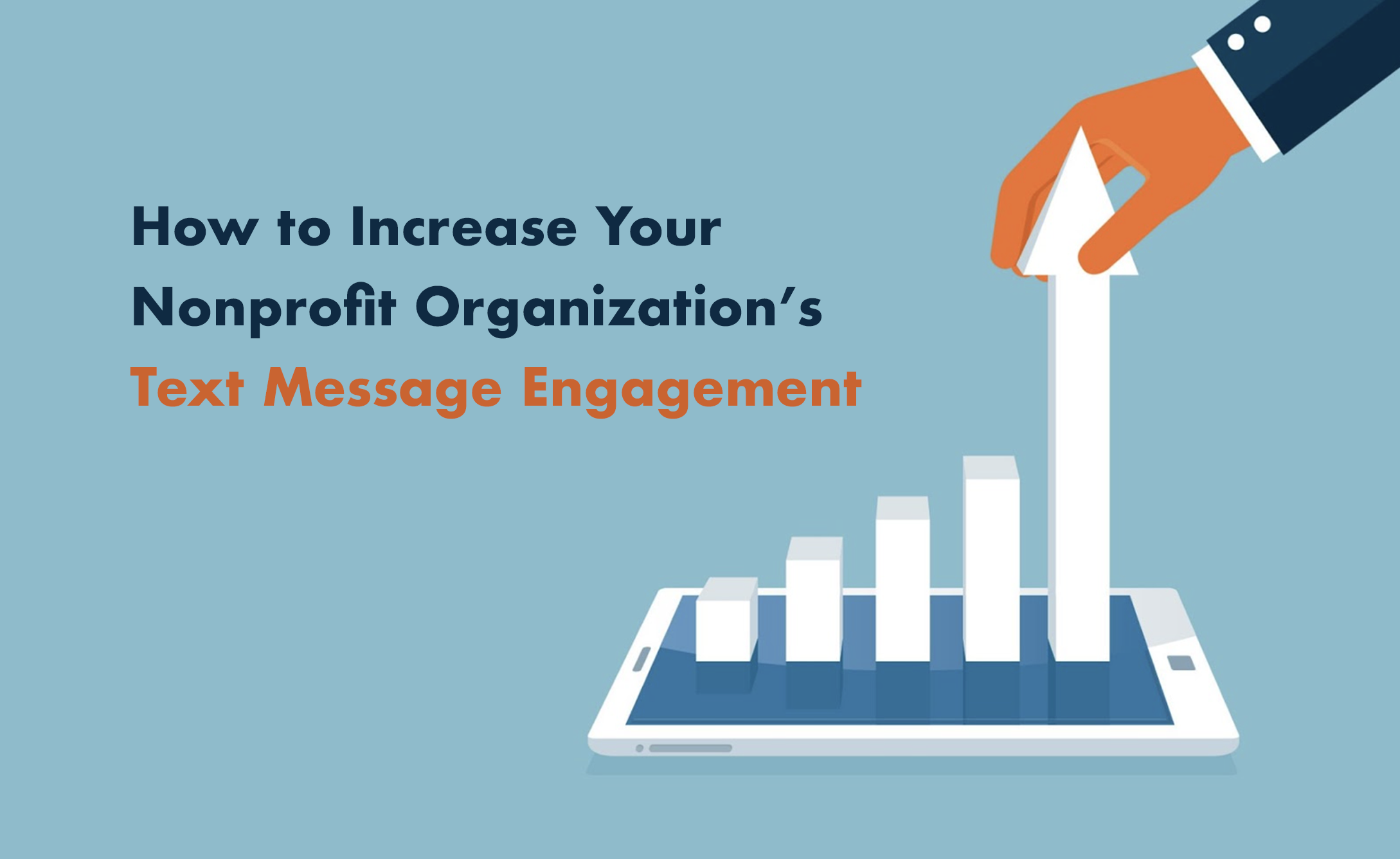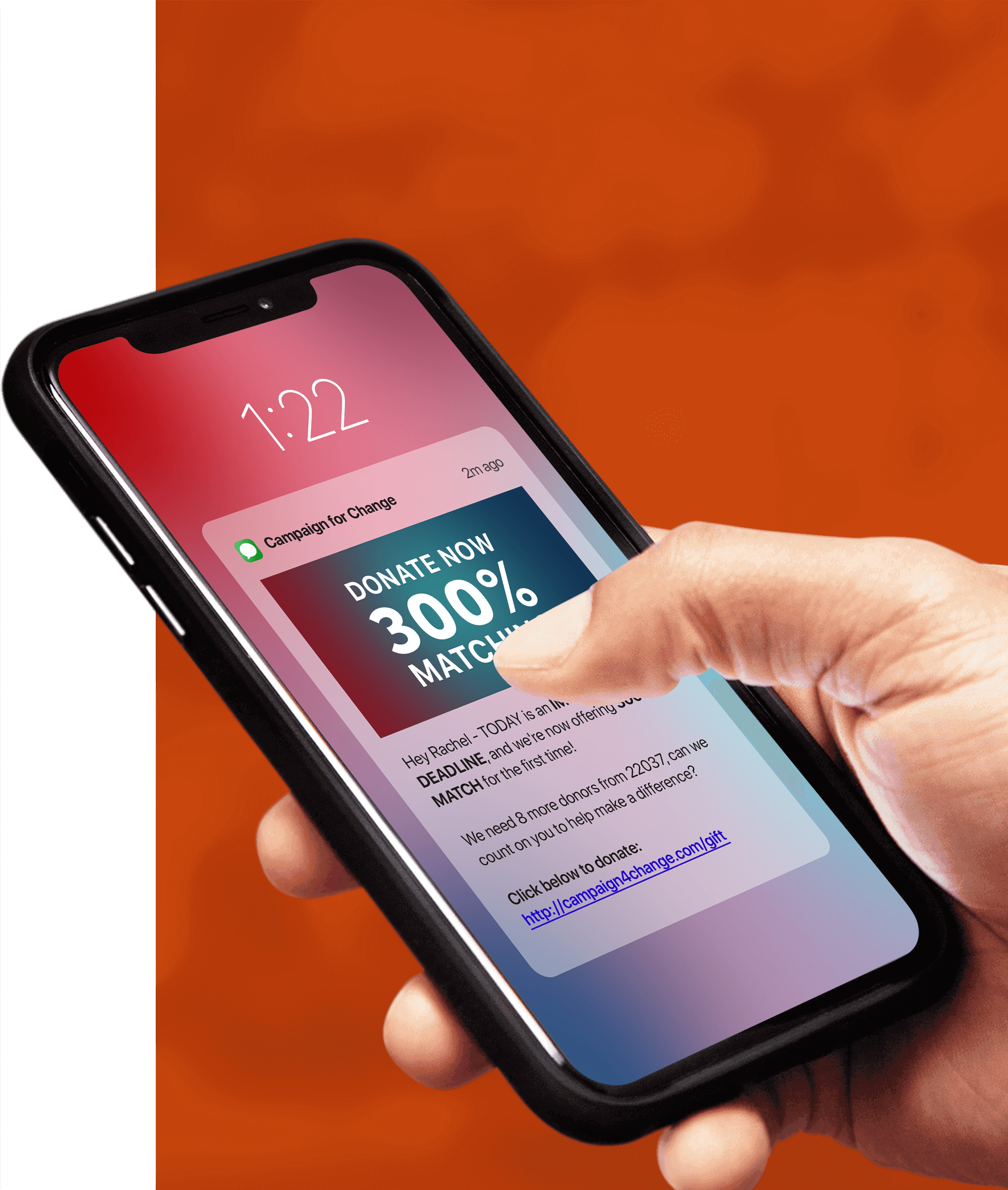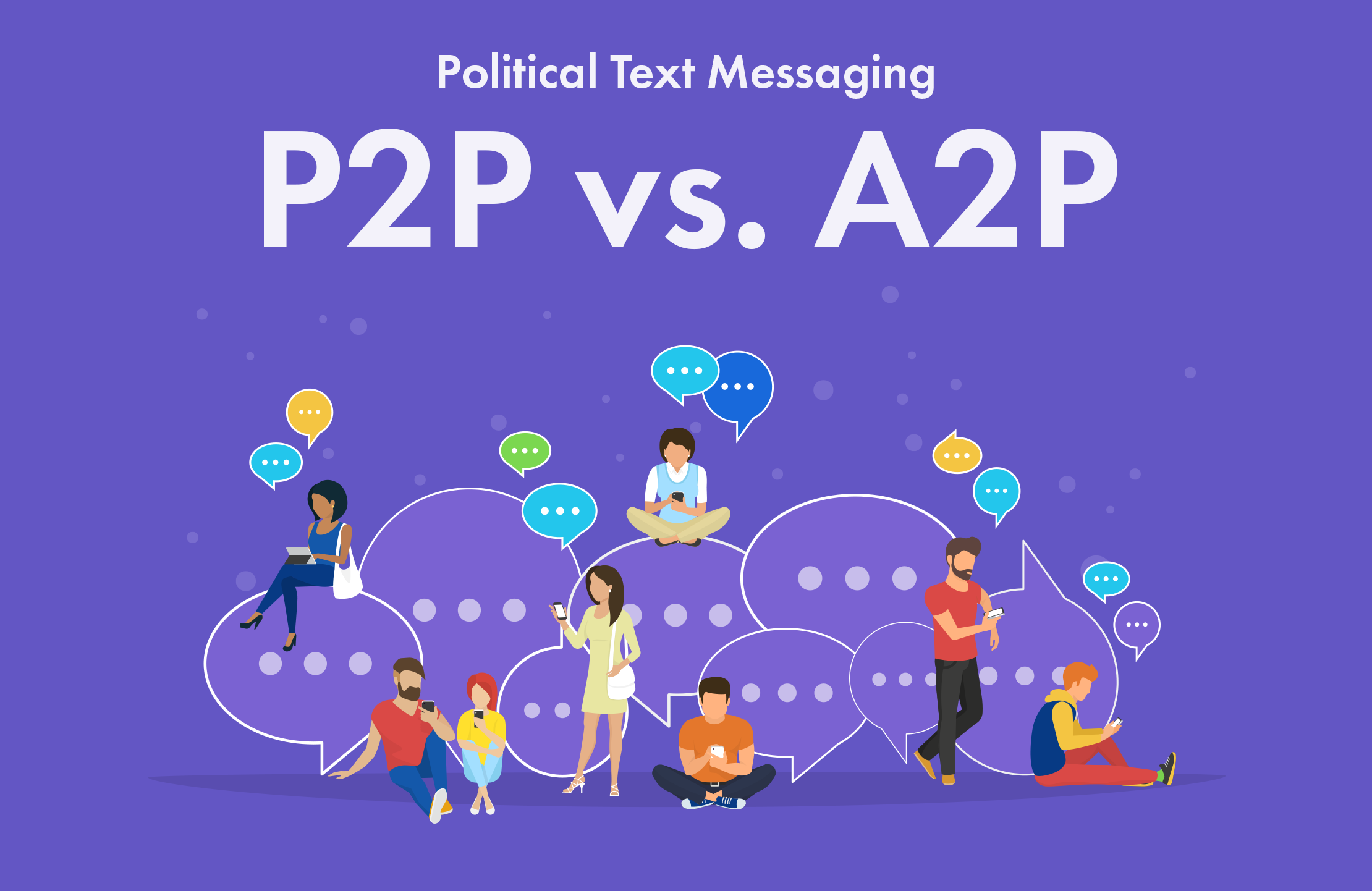
If you’ve been around the SMS marketing industry for a while, you may have heard of P2P and A2P messaging. While these sound technical, there is an easy way to understand the difference between the two. In this blog post, we define A2P and P2P messaging, compare the two, and provide examples of both. Because we support political candidates through our A2P text messaging platform, we also share examples of how A2P and P2P work together to create winning campaigns.
What Is P2P SMS Messaging?
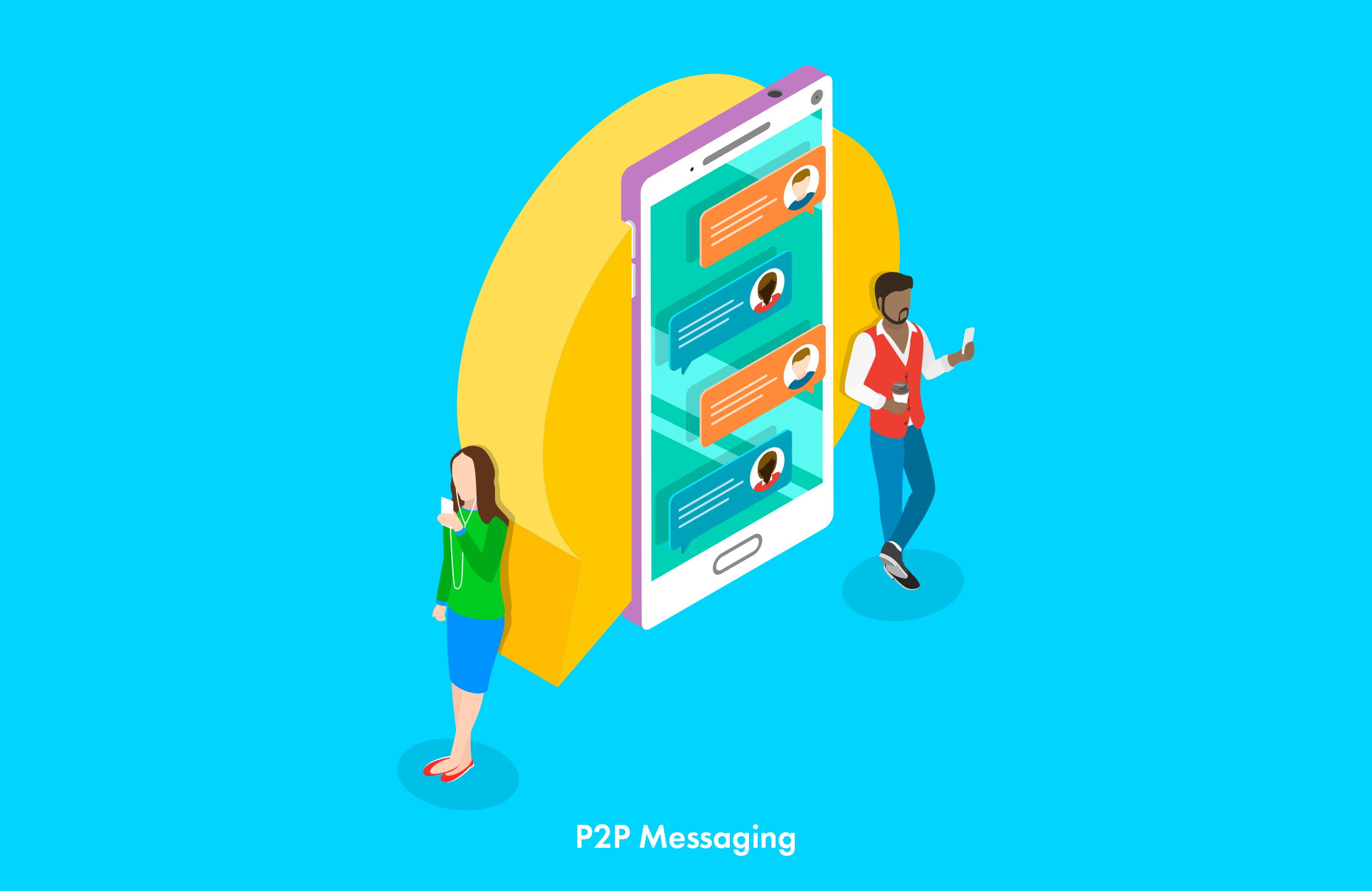
P2P stands for person-to-person or peer-to-peer. Easy to remember, right? So, P2P messaging is essentially when one person texts another person. You may not be aware of it, but you already use P2P messaging every day when you text friends and family. You’re one person (P) sending a text to (2) another person (P).
P2P messaging occurs between long codes (10-digit phone numbers), just like the phone number you use every day as your main cell phone number.
The following are a few popular examples of P2P messaging.
Examples of P2P Messaging
P2P messaging is commonly used for:
- Texts from one person to another
- Group texts from one person to a few friends
Essentially, P2P texting is the most basic form of text messaging. It’s the kind you use every day to text your friends, relatives, and colleagues.
Rules and Regulations of P2P Messaging
Because P2P messaging is more manual and small-scale (occurring between two individuals or among a small group), it’s not as heavily regulated as A2P messaging, which you’ll learn more about in a moment.
With P2P messaging, all you need is a working 10-digit cell phone number and an account with a mobile carrier such as T-Mobile, Verizon, or AT&T. No one is required to opt in to receive your text messages. However, it’s always wise to ensure your intended recipient wants to hear from you before you text them.
How Can Political Candidates and Organizations Use P2P Messaging?
Although it’s more time intensive and at a small scale, P2P messaging has its place in an effective political SMS marketing strategy. For example, volunteers for a political campaign often text voters to remind them about important upcoming election dates, ask if they’re willing to help get out the vote, or send them information on how to register to vote.
Because P2P is one-on-one, recipients aren’t required to opt in to receive texts. However, it’s always best practice to be sure people have asked to receive your text messages. Texting without their consent can feel like a violation of privacy and leave a poor impression of your political campaign (which is precisely the opposite intended effect).
P2P is part of a holistic political SMS marketing strategy alongside A2P SMS messaging. Next, let’s dive into A2P and discuss how political campaigns are using it.
What Is A2P SMS Messaging?

A2P stands for application-to-person. It occurs when a text is sent out to many people over a text marketing platform—an application. A2P messaging differs from P2P messaging in that, with A2P, texts can be sent from one to many through an automated system. It’s not just one person directly texting another person. Retailers, restaurants, political organizations, and advocacy groups use A2P messaging to send texts to large subscriber lists about important dates, coupons, events, mobile alerts, and reminders.
Examples of A2P Messaging
The following are some popular examples of A2P messaging.
Coupons
Retailers, restaurants, and entertainment companies often use A2P messaging to send coupons, deals, and mobile alerts to subscribers. This form of A2P messaging can be done on long codes and short codes.Many retailers offer an incentive for joining their mobile program at a point of sale (cash register) or on the retailer’s website, such as 10 percent off your next purchase.
Appointment Reminders
Many service-based businesses such as doctors’ and dentists’ offices, hair stylists, and estheticians send appointment reminders and scheduling notifications using A2P messaging. While they’re technically texting a single person (you) with the appointment reminder, they’re using an automated application to send the message. Thus, this type of message qualifies as A2P messaging. This form of A2P messaging typically goes out from a long code rather than a short code.
Fundraising
Political groups and candidates as well as nonprofit organizations often use A2P messaging for fundraising. In fact, A2P messaging is so effective for gathering donations, that many Tatango clients see a return of $5 for every $1 they invest on A2P messaging, on average.
SMS marketing is a far more effective way than traditional marketing channels to fundraise for your campaign or organization because 99 percent of text messages are opened (compared to only 20 percent of email marketing messages), and 90 percent of text messages are read within just three minutes. Additionally, A2P messaging requires subscriber opt-in. This step ensures that people receiving your messages really do want to receive them, further increasing your likelihood of receiving donations with every A2P text message you send.
Emergency Notifications and Alerts
A2P messaging is also frequently used to send out emergency notifications and alerts. If you’ve ever received an AMBER Alert about a missing person, that’s a form of A2P messaging because it went out through an application.
Rules and Regulations of A2P Messaging
A2P messaging can be more promotional in nature, therefore it’s subject to stricter regulation by the Federal Communications Commission (FCC). The FCC developed a law called the Telephone Consumer Protection Act (TCPA) that governs text message marketing. While we have an entire library of resources about the TCPA and take great pride in helping our clients successfully and legally navigate it, the following are a some main points to always keep in mind.
First and foremost, when using A2P messaging, you must obtain consent from someone to text message them. That means they must check a box on your website or in some other way, through written consent, indicate they’re aware they’re providing their phone number for you to text them going forward.
At Tatango, we recommend using a double opt-in process to make this consent crystal clear. For example, once someone opts in to your SMS marketing campaign by texting a keyword like VOTE to a short code like 12345, you can set up an automatic follow-up text confirming they wish to receive messages from your organization. While this may seem like an extra step, it’s the only way to verify that someone didn’t accidentally opt in to your campaign (or that someone else didn’t opt in for them without their knowledge).
Because organizations that violate the TCPA can be fined up to $1,500 per text message—per person—it’s not worth skipping this important due process and risking millions of dollars in fines. (Contact our text message marketing experts if you need help setting up or safeguarding your campaigns.)
How Can Political Candidates and Organizations Use A2P Messaging?
With 13 years of experience in SMS marketing (specifically A2P messaging) we know what works and what doesn’t for political campaigns that want to raise funds and win elections. The following are the most common ways political groups and organizations use A2P messaging.
Fundraising
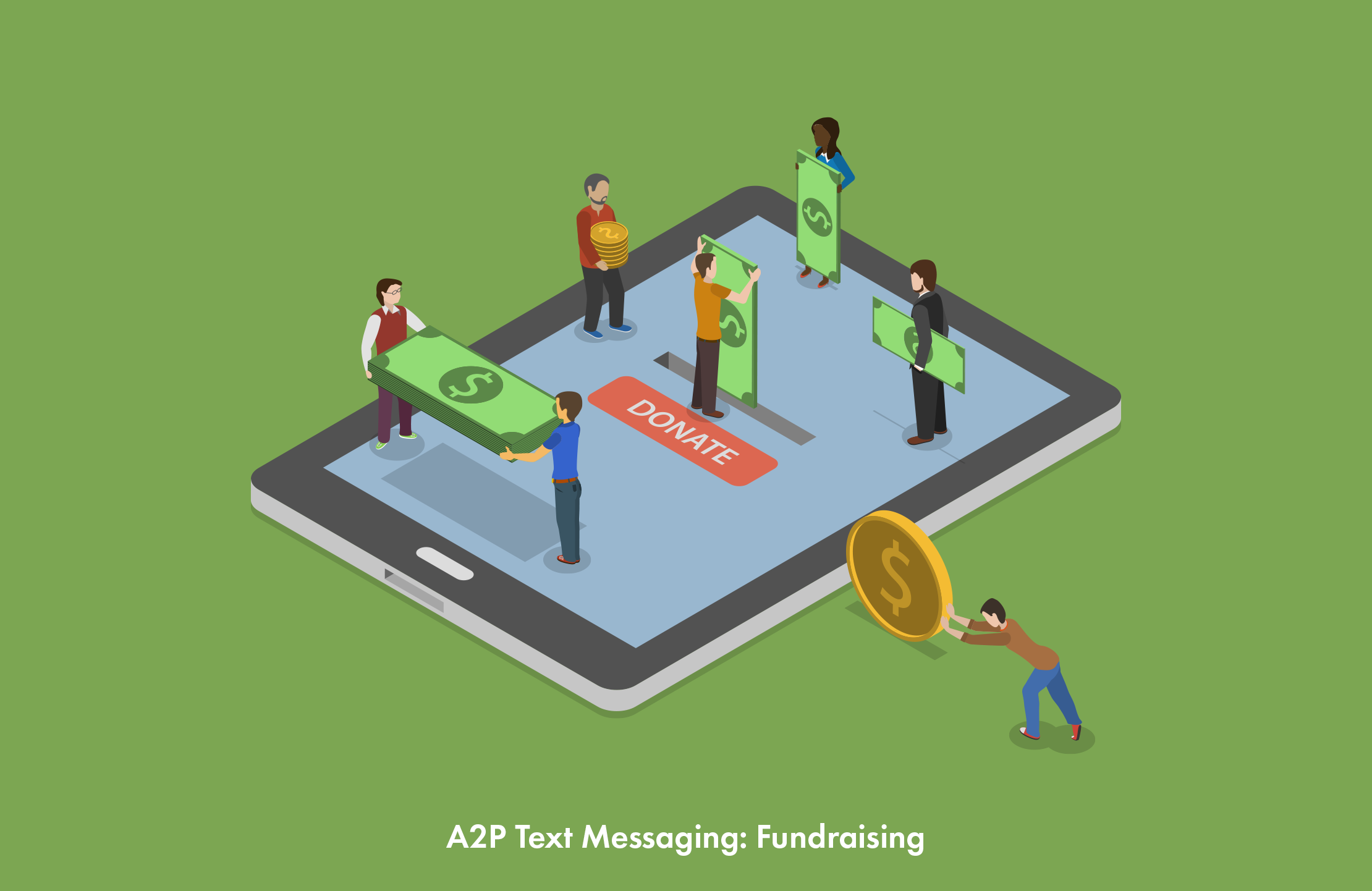
Fundraising text messaging is one of the most popular messaging formats for political groups and organizations. Across all presidential candidate campaigns in the 2020 presidential election, 45 percent of text messages were direct requests for donations.
Political candidates frequently message subscribers to invite them to get involved and support important campaign issues with donations. Leading up to the recent election, more than 5 billion political text messages went out in October 2020 alone.
Even small-dollar donations add up. In the 2020 presidential election, 49 percent of Donald Trump’s $773,954,550 in donations came from small donors, whereas 38.94 percent of Joe Biden’s $1,044,187,828 in donations came from small donors.
Get Out the Vote
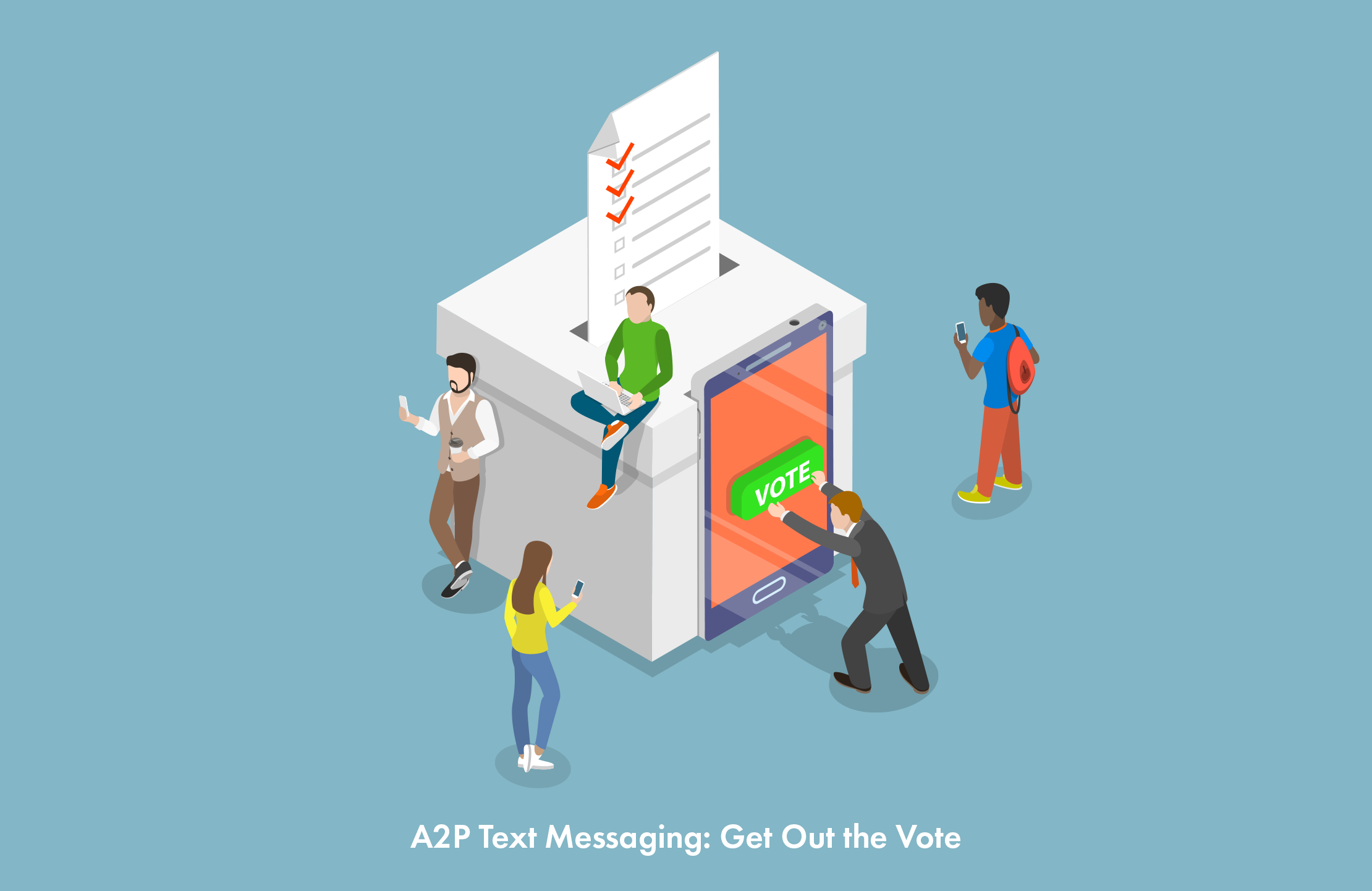
Another objective for which many political campaigns and organizations turn to A2P messaging is to get out the vote (GOTV), or increase voter turnout. In fact, 60 percent of text messages were related to GOTV efforts during the 2020 presidential election.
Recent elections have been incredibly close. Analysis shows that registered voters between the ages of 27 and 50 who received an SMS marketing message turned out to vote at a rate of almost 8 percent higher than those in the same age group who didn’t receive an SMS message.
The 2020 presidential election came down to a difference of just a few percentage points. With stakes like these, SMS marketing can make all the difference in winning an election.
Election Reminders
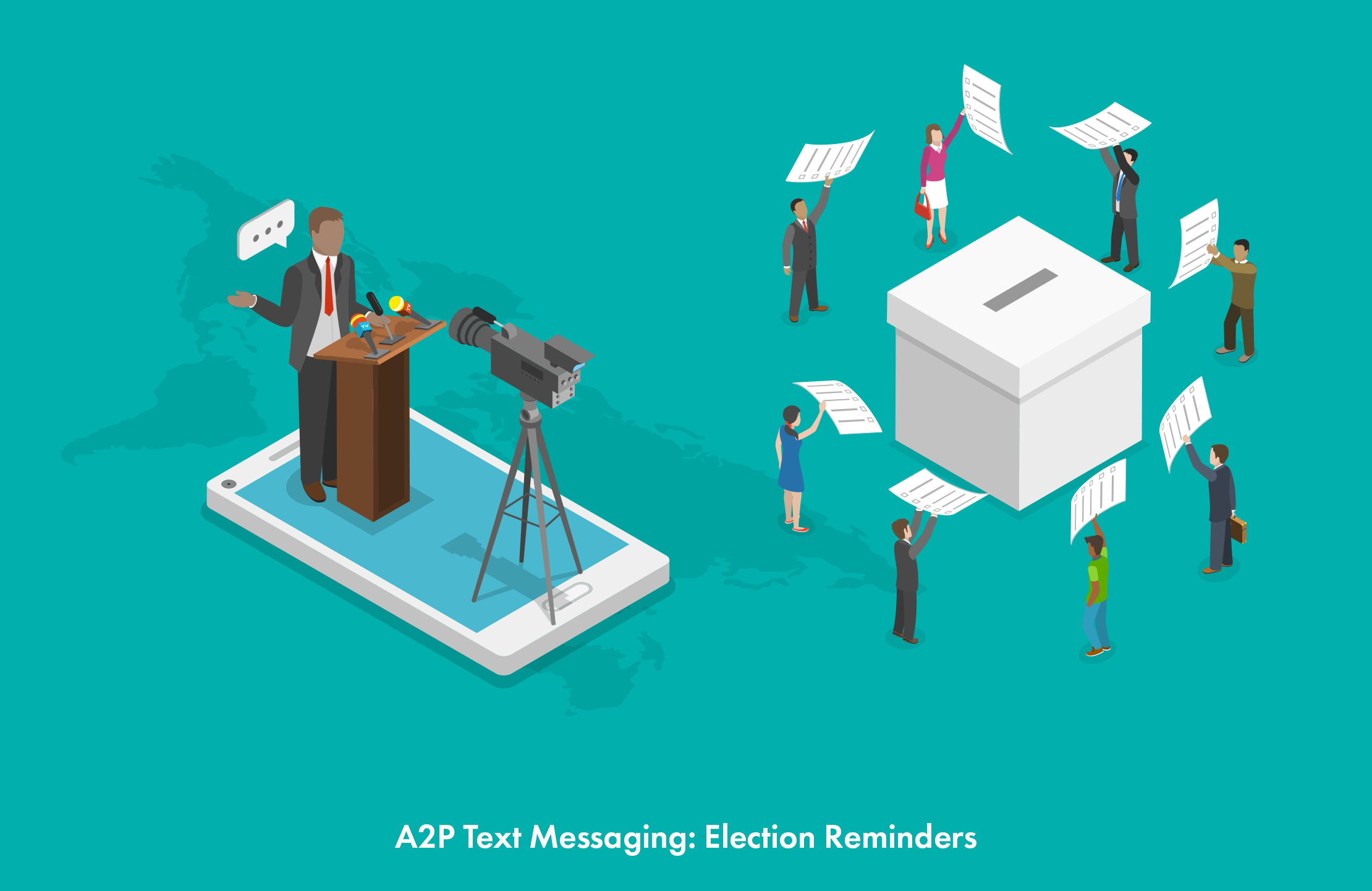
As well intentioned as voters may be, people have a lot to keep track of beyond politics, and they may not always be aware of important election dates. That’s why SMS marketing can be so helpful in political campaigns—it helps keep supporters informed about elections, registration deadlines, and even the dates for smaller elections that the average voter may not be aware of. Keeping voters informed about election details helps campaigns win by increasing voter turnout, particularly in close races.
Campaign Updates
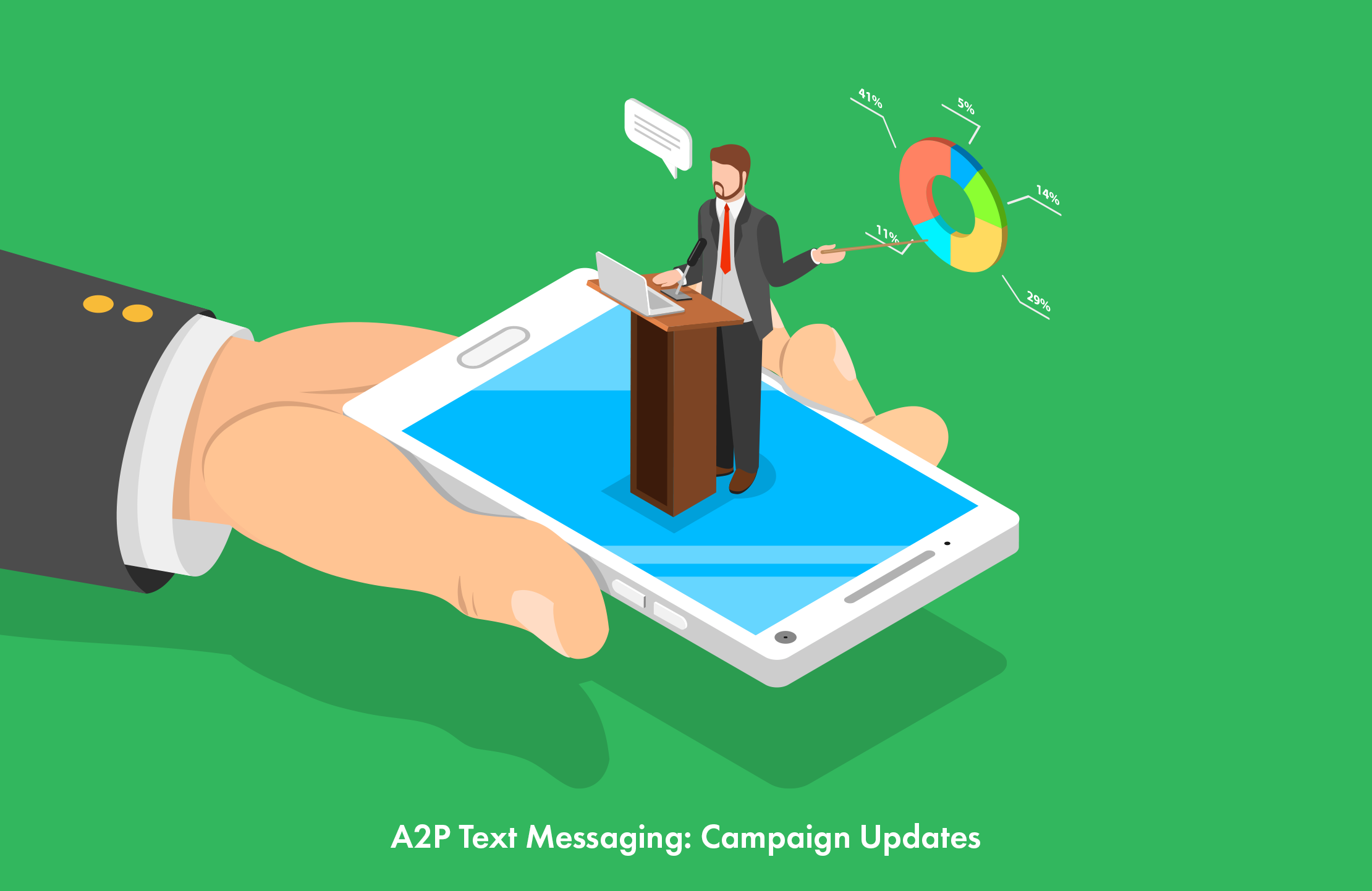
Political campaigns also use A2P messaging to send campaign updates such as behind-the-scenes photos, information on policy positions, and direct communication from the candidate to their supporters. Social media is very unpredictable with regard to censorship and even with what the algorithm shows followers of a campaign’s Facebook. With SMS marketing, a political candidate can communicate directly with constituents and can be confident that recipients will see virtually every message. SMS marketing is an excellent way to make constituents feel like they’re part of a movement, making them more likely to volunteer, donate, and vote when it matters most.
The Difference Between A2P and P2P Messaging
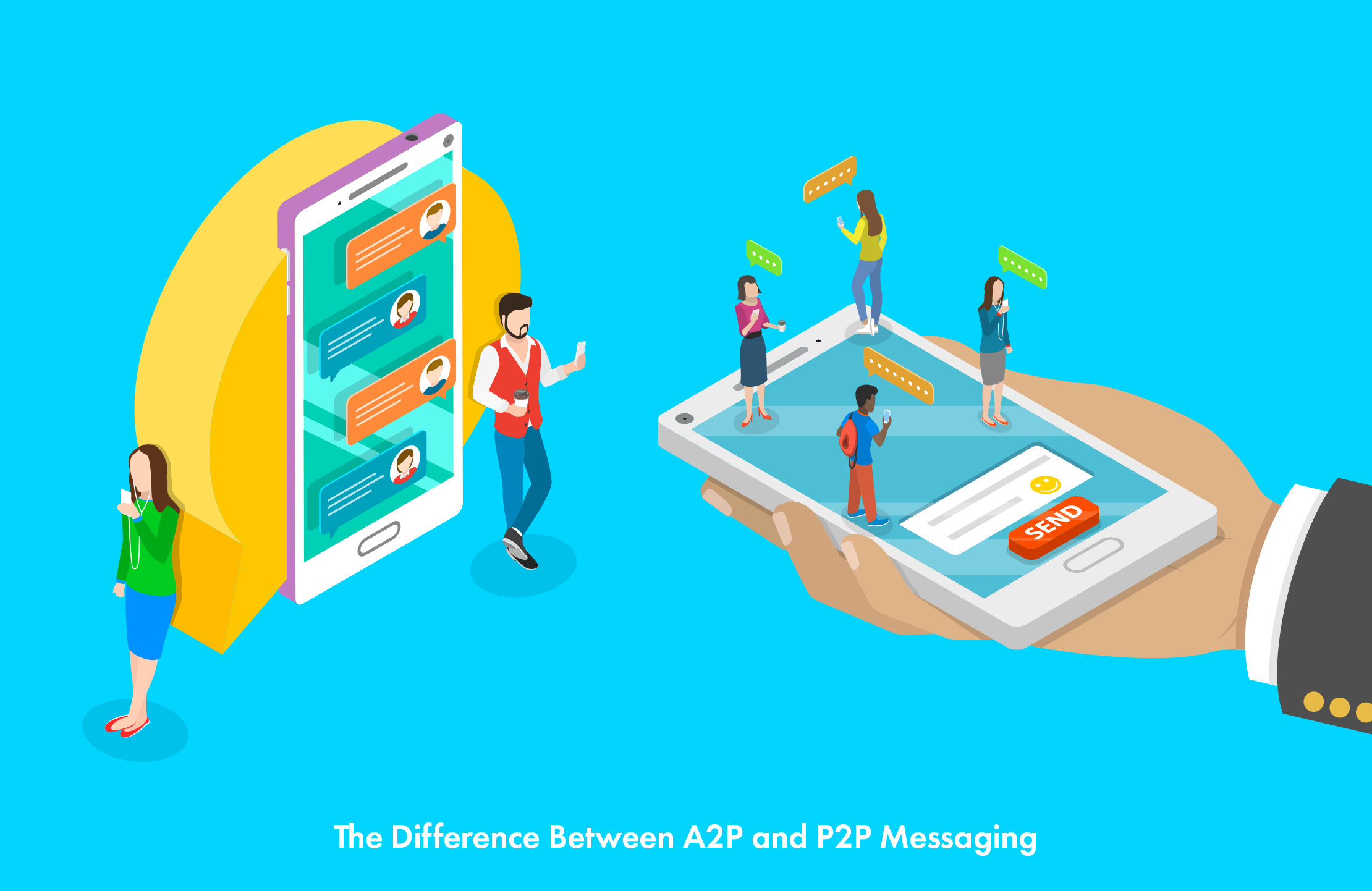
Recall that P2P messaging is person to person or peer to peer (the clue is in the P’s), and A2P messaging is application to person (the clue is in the A). The difference is essentially that P2P is one-to-one messaging and A2P is one-to-many messaging.
All P2P messaging operates on long codes (10-digit phone numbers), and most A2P messaging operates on short codes (five- or six-digit phone numbers) because they’re easier for people to remember from websites, podiums, campaign materials, ads, and billboards.
P2P messaging doesn’t require an opt-in, however if your organization plans on texting individual people, it’s always a smart move to ensure they want (and expect) to hear from you. A phone number is still the most personal form of technological access to a person, so it’s in your organization and campaign’s best interest to respect this boundary.
A2P messaging does require an opt-in, that is, written consent from the text message recipient to contact them through a text message marketing application or platform like Tatango.
Getting Started with A2P Messaging
Are you ready to start taking advantage of text message marketing’s 99 percent open rate and drive more votes, donations, and support to your political campaign or organization? Find out how Tatango can help you raise funds, break records, and win elections. We’ve been an industry leader for over 13 years and have the fastest send speeds, the strongest security, and the most dedicated support teams in the industry. Contact one of our A2P messaging experts to get started today.
